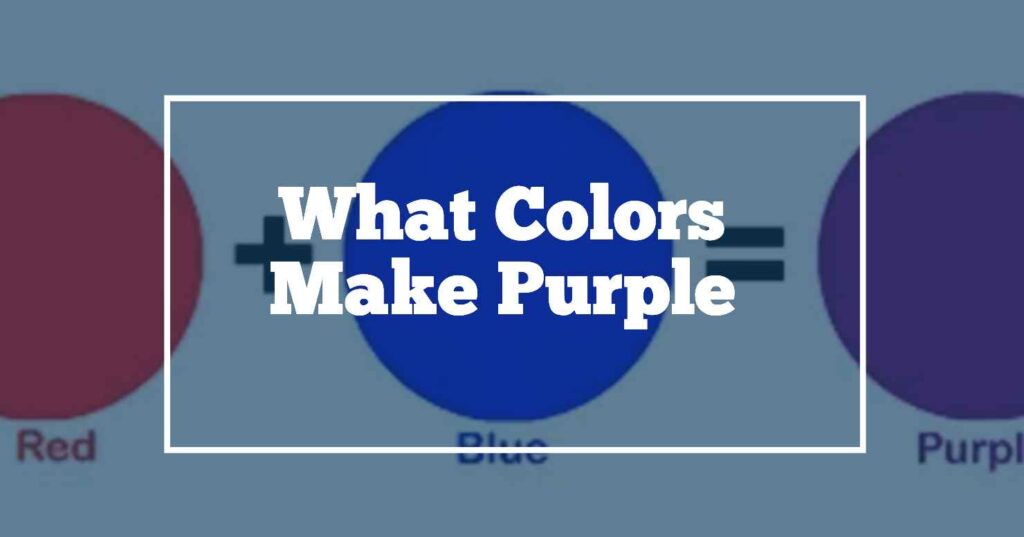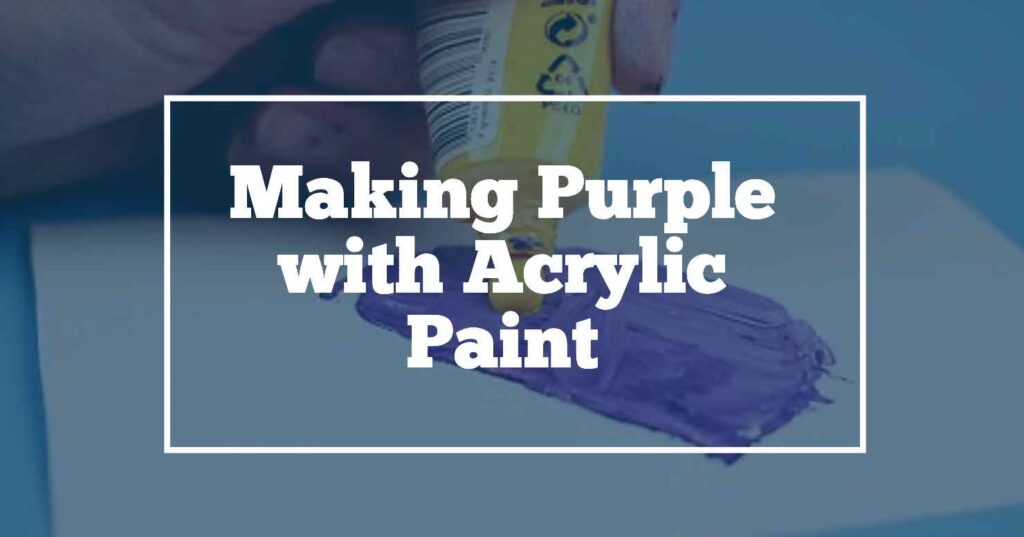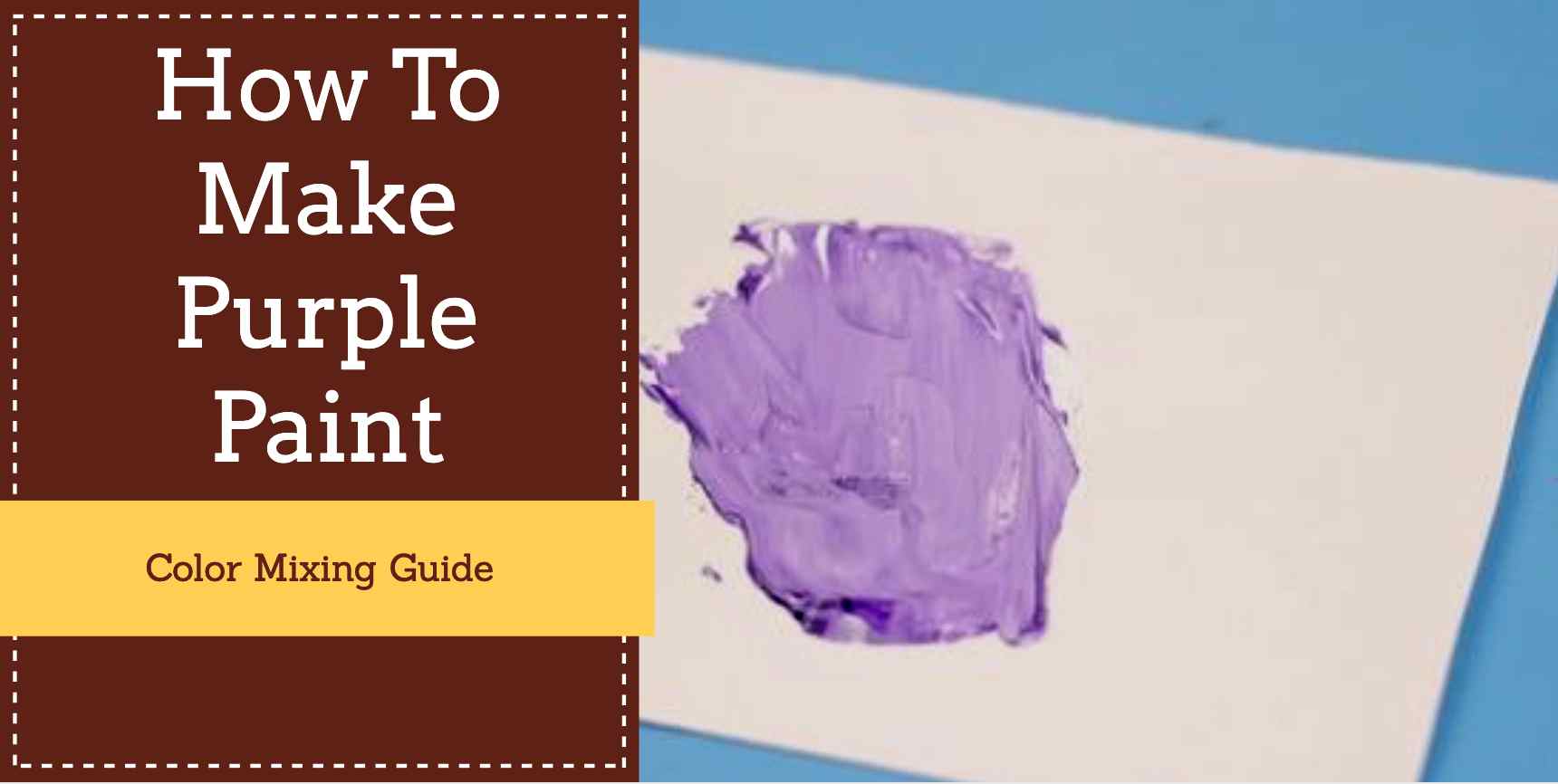Do you like the color purple? A lot of people do. If you’re painting and you run out of purple paint, you can make it at your own home. This is easy and exciting! You can use various paint types, like oil paint, acrylics, or watercolors. All you have to do is mix red and blue paint together. But how much of each? We’ll guide you on, how you can get the best purple for your art. Let’s learn how to mix different shades to make them get a great purple color.
Making Purple: Which Two Colors to Mix?

Have you ever wondered how to make purple color by mixing two colors if you don’t have any? The secret is simple: mix red and blue. When you combine them, you get purple. The shade of purple can be different depending on how much red or blue you use. If you use more red, your purple will be warmer. If you use more blue, your purple will be cooler. Every time you mix, it can be a new shade. You can check which two colors to mix for making Hot Pink at your own home. It’s like a fun game. If you ever don’t have purple paint, just remember to mix red and blue. It’s more than just making a color; it’s all about enjoying the process of making purple paint yourself.
Making Purple Using Oil Paint: Follow These Steps
Hello to all the artists out there! Want to make your own purple shade with oil paints? Let’s go step by step:
- Set Up: First, make sure you have a clean place to work. Get your paint palette ready and also some brushes. It might be good to have some paper towels or old rags nearby, just in case.
- Start with Blue Paint: On your palette, put a bit of blue oil paint. Keep in mind, that you can always add more paint if you need it.
- Now, Mix in Some Red: Next to the blue, add some red paint. Then, with a brush, mix a little red into the blue. Watch as they blend and turn purple!
- Look at the Color: Keep checking the mix. If it looks too blue, add some more red. If it looks too red, put in a little more blue.
- Make Sure It’s Mixed Well: Mixing well is important. The red and blue should come together nicely.
- Test the Color: Before using it on your main painting, try it out on scrap paper or an old canvas piece. This helps you see if you get the desired shade you want.
- Tweak the Color if You Need To: If the purple isn’t how you like it, adjust it. Add a bit more red or blue until it’s just right.
With these steps, you can make a purple shade in the comfort of your home, using just two colors. You can go through this guide If you want to make Violet paint using different types of paints.
Making Purple with Acrylic Paint: Easy-to-Follow Steps

Hello! As we already told you a method to make purple shade using Oilpaint. Now, we’re going to make purple using acrylic paint. Instead of using pre-made purple, we’ll create our own. Making colors is fun and rewarding as well, just like cooking. Ready to get started? Let’s go.
- Prepare Your Space: All artists need a tidy space. Choose a spot like a table or floor where you can set up everything. You’ll need a palette (even a plain plate will work), blue and red acrylic paint, a tool to mix with (like a palette knife or spatula), and some clean brushes.
- Start with Blue: Put a good amount of blue paint on your palette. Blue is a strong color and a great starting point for making purple.
- Add Red: Next to the blue, add almost the same amount of red paint. You might not need an exact half-and-half mix of blue and red to get the perfect purple, but that’s part of the fun!
- Mix Them: Using your mixing tool, combine the blue and red. Stir them together, and you’ll see them begin to turn purple.
- Check the Color: Look at your mixed color. If it’s too dark, add more red. If it’s too light or pinkish, add more blue.
- Get the Right Feel: Acrylic paint should feel smooth. If it’s too thick, you can add a little water. Mix until it feels just right for painting.
- Try It Out: Before using it on your main painting, test the purple on a scrap of paper or a small part of your canvas. If it doesn’t look quite right, you can always adjust the mix.
- Make Adjustments: Purple comes in many shades. If you want a lighter purple, you can add a bit of white. If you want a darker purple, add some black or more blue.
- Save for Later: If you made more purple paint than you need now, put it in a tight-sealing container. This way, you can use it again later.
- Clean Up: Clean your brushes and tools when you’re done. Dried acrylic paint can be hard to remove.
And that’s it! With just two colors, you’ve made your very own shade of purple. When people see your painting, you can tell them you mixed that purple yourself. Mixing your own colors makes your artwork even more special. Every painting you make will be unique because of the extra care and personal touch you add. Now, use your new purple and enjoy painting!
Creating Purple Using Watercolors: A Detailed Guide
Hello, art aficionados! Now, the next method is about making purple using Watercolors. Watercolors bring a unique essence to art, and today, we’re diving into the straight process of creating that ideal shade of purple using watercolors. If you’re curious about how to get the perfect purple hue, you’re in the right place. Let’s start in!
- Setting Up Your Space: Begin by preparing your workspace. Opt for a spot with an ample amount of light. Organize your watercolor paper, brushes, a water bowl, and your blue and red watercolor pans or tubes.
- Moistening the Brush: Submerge a clean brush into your water bowl. This moisture is crucial to extract and manipulate the pigment from watercolors effectively.
- Adding Blue: Wet your brush and pick up some blue paint. Put this on your palette or dish. You’ll see the water mix with the color.
- Adding Red: With a different brush (to keep colors pure), get some red paint. Mix it with the blue. The water makes the colors blend well.
- Mixing: Mix the colors softly. When blue and red mix, you’ll see a new purple color.
- Check and Adjust: Look at the new color. If it looks too blue, add more red. If it looks too pink, add more blue. Watercolors have small color changes.
- Test the Thickness: The balance of paint and water is important. For a lighter color, add more water. If it’s too thin, add more paint to make it thicker.
- Try It Out: Before painting your main picture, paint a small line of your purple mix on another paper. This lets you see how it looks.
- Customize the Color: Watercolors are flexible. Add more water or a little white to get a light purple. For a darker purple, use a darker blue or a bit of black.
- Save Your Mix: If you have made a lot of the color and want to use it later, put it in a small container. Dry watercolors can be made wet again with water.
- Clean Up: After painting, wash your brushes. Even though dried paint can be wet again, clean tools last longer.
In this way, you’ve made your own perfect purple shade using watercolors. sitting straight from your own home.
How To Make Bright Purple Paint
Materials You Need to Make Bright Purple:
- Red paint (bright or primary red)
- Blue paint (bright or primary blue)
- White paint (optional, for making it lighter)
- A place to mix the paint, like a palette or paper
- Paintbrushes
- Water (if you’re using acrylic paint)
Steps to Make Bright Purple Paint:
- Get ready: Find a spot to mix your paint, and have everything you need nearby.
- Pick your paints: Choose a bright red paint and a bright blue paint. These colors make the best purple.
- Put some paint on your palette: Squeeze a bit of red and blue paint next to each other on your palette. Start with the same amount of each.
- Mix them together: Use a brush or something to mix the red and blue paints really well. Start with equal amounts, and then adjust if you want the purple to be more red or more blue.
- Optional: Make it lighter: If you want the purple to be brighter, add a tiny bit of white paint. Be careful not to use too much; a little goes a long way. Mix it in until you like the color.
- Test it: Before using your purple on your painting, try it on a scrap piece of paper or canvas to make sure it’s the right shade.
- Fix it if needed: If the color isn’t perfect, you can always add more red, blue, or white to get it just right.
- Clean your brushes: After you’re done, clean your brushes with water (if you’re using acrylics) or the right cleaning stuff (if you’re using oil paint).
Remember, the exact purple you make might be a bit different depending on the paints you use. But with practice, you’ll get better at mixing the perfect bright purple for your art.
How To Make Light Purple Paint
Creating light purple paint is similar to making bright purple paint but with more focus on adding white to lighten the color. Here’s how you can make light purple paint :
Materials You Need To Make Light Purple:
- Red paint (bright or primary red)
- Blue paint (bright or primary blue)
- White paint
- Palette or mixing surface
- Paintbrushes
- Water (if using acrylic paint)
Steps to Make Light Purple Paint:
- Prepare your workspace: Find a clean surface to mix your paint and have your materials ready.
- Select your red and blue paints: Choose a bright or primary red paint and a bright or primary blue paint, just like before.
- Squeeze paint onto the palette: Place a small amount of red and blue paint on your palette, side by side.
- Mix red and blue: Use a brush or palette knife to thoroughly mix the red and blue paints together. Start with roughly equal amounts.
- Add white: To make the purple lighter and closer to light purple, add some white paint. Begin with a small amount, as you can always add more if needed. Mix the white in until you achieve the lightness you desire.
- Test your paint: Before using it on your artwork, test your light purple paint on a scrap piece of paper or canvas to ensure it’s the right shade for your project.
- Adjust if necessary: If the color isn’t quite what you want, you can make it lighter by adding more white or adjust the hue by adding a bit more red or blue as needed.
- Clean your brushes: After you’re done painting, make sure to clean your brushes thoroughly with water (for acrylics) or the appropriate solvent (for oil paints) to prevent color contamination.
By following these steps, you can easily create light purple paint for your projects.
FAQs: Making Purple Paint with Acrylics, Oil Paints, and Watercolors
- Why Make Purple When I Can Buy It?
Great question! While purchasing a tube of purple is definitely convenient, mixing your own allows for customization. Whether you’re aiming for a soft lilac or a deep aubergine, creating your shade ensures it’s uniquely yours. Plus, there’s an undeniable sense of satisfaction in nailing that perfect hue on your own. - Which Colors Do I Mix to Make Purple?
The basics remain unchanged across mediums: combine blue and red. However, the ratio and the shades of blue and red can vary, affecting the final outcome. - Can I Use Any Blue and Red?
While any blue and red can produce a variant of purple, specific shades will give you more control over the result. For instance, cobalt blue and crimson red might give you a vibrant purple, while ultramarine and alizarin crimson might result in a richer, deeper hue. - How Do I Lighten or Darken My Purple?
Whether it’s acrylic, oil, or watercolor, adding white will lighten the shade, whereas a touch of black or more blue can give it a darker, more profound depth. However, be cautious; a little goes a long way. - Is the Mixing Technique Different for Each Medium?
Yes, indeed! With acrylics, you’re mixing dense pigments, so the colors blend quickly. Oil paints are thicker and might require a bit more effort, and adding mediums like linseed oil can help in blending. Watercolors, being water-based, merge more fluidly due to the water’s blending properties. - What If I Make Too Much? Can I Store It?
Absolutely! Acrylic paint can be stored in airtight containers to prevent drying out. Oil paint, due to its slower drying time, can also be preserved this way. Watercolors, once dried, can be reactivated with water, so storing excess isn’t typically necessary. - Why Does My Purple Look Different on Paper Than on the Palette?
Different mediums dry differently. Acrylics might darken a tad when dry, oil paints generally retain their wet color once dried, and watercolors can appear lighter once the water evaporates. - Can I Mix Other Colors into My Purple?
Of course! Art is all about experimentation. Adding yellow can give you a warmer, more earthy purple, while a touch of green can mute it for a more subdued shade.
Conclusion
Alright, we’ve talked a lot about making purple paint using acrylics, oil paints, and watercolors. It’s clear that combining blue and red gives us this beautiful color. Different types of paints might need slightly different approaches, but the basics stay the same. By now, you should feel ready to try making purple on your own. Remember, your shade of purple will be unique, just like your art. So, enjoy the process, have fun mixing, and let’s fill our art with the best shades of purple we can create.

